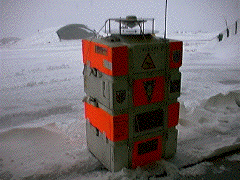SAOZ Balloon
| The SAOZ Balloon gondola is a UV-visible spectrometer able to provide vertical profiles of O3, NO2, OClO, BrO and H2O by solar occultation during ascent of the balloon (or descent) and from float at 30 km during sunset (or sunrise).
The instrument is driven by an on-board computer, connected to a PTU (Pressure, Temperature and Humidity) sensor, a GPS (Global Positioning system ) for the localistion (Altitude, latitude and longitude) and an Argos transmitter for the recovery of the payload after cut-down and descent under parachute.
The weight of the instrument is 20 Kg. It is launched under the small balloons 5 ZL and 10 ZL ( 5 000 et 10 000 m3) developped by the Centre National d'Etudes Spatiales (CNES).
SAOZ TEAM on launch pad. |
|
|
|
 |
Since 1991, about 100 flights have occured in France, Spain, Norway, Sweden and Brasil in order to study the ozone loss and the chemistry of Chlorine, Bromine and Iodine species. (See Flight list).
The data are available at NILU, Norway on the European Data Base "ZARDOZ" and here (See Processed List)
Picture Gallery during THESEO/O3Loss and THESEO2000/SOLVE.
A long duration version of the same instrument has been developped which flew under MIR (Infra-Red Monfgolfier) at the Equator in 1995 and in the Arctic successively in 1997, 1999 and 2000. (See THESEO/Lagrangian experiment)
PROGRAMME:
ODIN Validation
ENVISAT Validation
NO2 profiles evolution in summer since 1992
O3, NO2 and H2O injection at Tropics
Prepared by CNRS / IPSL-SA, Verrières Le Buisson, France. florence.goutail@aerov.jussieu.fr